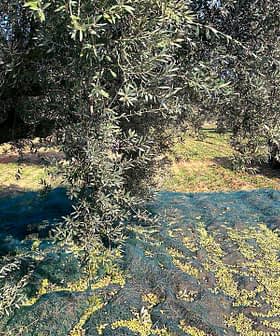An expansion of the country’s olive groves and mostly favorable weather mean Australians expect an excellent harvest in 2022.
“After the drought of the previous year, the worst I’d ever seen, last year we had a record harvest of 140,000 tons of olives,” Michael Southan, chief executive director at the Australian Olive Association (AOA), told Olive Oil Times. “We do not expect to replicate that in the incoming season, but we are off for a good harvest indeed.”
Growers are learning how to manage their orchards better. In the past, many olive groves were not as productive as they could have been, and that is changing.
The climate has always been the biggest challenge for the country’s olive farms, especially in recent years, as the devastating floods in New South Wales in 2021 followed an exceptional drought that already had affected most agricultural producers in Australia.
“The challenge is the weather’s extraordinary variability, as every year growers have to face opposite scenarios and need to adapt to extremes,” Southan said. “In the last couple of years, we have been lucky as we had good rainfall in many areas, and the weather has been substantially good for olive growth.”
See Also:Farmers in New Zealand Optimistic Ahead of HarvestIn terms of volumes, the producing capacity shown by the sector in the last decades has been steadily growing.
“It has gone up for the last 20 years,” Southan said. “We can say the industry is 30 years old, so we went from practically zero 30 years ago to the last year’s record, with over 23 million liters produced, mostly extra virgin olive oil.”
AOA data from the last 10 harvests show olive production increasing from 14,500 tons in 2010/11 to almost 20,000 tons in 2014/15 and up to more than 22,000 tons in the last crop year. Even considering the alternate bearing nature of the olive tree, the average harvest has followed a significant positive trend in this period.
According to Australian farmers, most of the growth is due to a better understanding of the olive tree characteristics, learning more efficient pruning techniques and better soil and land management protocols. All of this allowed for better yields and more efficient protection of trees’ health.
“Most now know how relevant it is to apply good farming and sustainable techniques,” Southan said. “Think of practices like chipping pruning remains and nurturing the soil with the resulting compost; it enriches the soil of olive groves and is also a carbon farming technique. Olives are carbon positive.”
Over time, Australian olive growers have also learned which varieties do best in each of the country’s unique olive-growing regions.
“Growers are learning how to manage their orchards better. In the past, many olive groves were not as productive as they could have been, and that is changing,” Southan said. “They realized which cultivars perform better in their environment, so they started planting new varieties and pulling those that did not work for them.”
“By participating in olive oil competitions and gathering together to discuss challenges and opportunities, olive growers are increasingly finding new ways to improve their orchards,” he added.
Another factor that bodes well for the current harvest is the abundance of workers available. Labor shortages have historically affected the industry, especially during Australia’s Covid-19-induced lockdowns.
“Labor has often been difficult to obtain in Australia, but I would expect it to be better this year for the olive industry,” Southan said.
Local authorities in several states also have supported the development of new techniques and the deployment of new procedures.
For example, a research project backed by the Australian government in New South Wales is using remote sensing technology to “assess plant health and also predict olive yields, giving growers spatial information to identify areas of low and high production and potential drivers of these yield variations.”
With the help of researchers from private and public institutions, irrigation deficit treatments also are being investigated and implemented. Plant sensors already have been installed to understand the relationship between irrigation methods and fruit yields.
Agricultural historians believe olive trees were first brought to Australia in 1800, 12 years after the first foreign settlement on the island.
John Macarthur, a pioneer of the local wool industry, is believed to have planted olive trees in the early 19th century. One of them is still thriving at the Elizabeth Farm in New South Wales, Macarthur’s former home.
In a study on olive tree history in the country published a few years ago, the researcher Rodney J. Mailer said European immigrants established some limited olive production in South Australia and Victoria.
Commercial olive farming began to take shape in 1890 when the New South Wales’ agriculture department started developing opportunities for olive farming.
In 1894, the experimental Wagga Wagga farm baptized an olive grove comprising all cultivars available in the region. By the end of the century, more than 60 cultivars had been gathered and planted in Wagga Wagga, which remains an important analysis and organoleptic laboratory.
According to Juan Vilar Strategic Consultants, most imported olive varieties came from Europe. However, the Lapierre olive tree, a South African variety, is believed to have arrived in Australia in the 18th century.
“This is possibly due to the waste dumping from a ship docked off the island, which had olive pits among the other dumped waste products,” the consultancy wrote. “The pits managed to take root and multiply on the island due to birds that dispersed them throughout.”
Australia’s modern olive-producing sector did not take shape until 1995, when the Australian Olive Association was formed. Today, olives are planted across Australia, with many varieties thriving from south Western Australia to Queensland in the northeast.
While almost 70 percent of Australian extra virgin olive oil production comes from the 2.5 million trees of Boundary Bend, hundreds of small and medium farmers have also specialized in olive growing and contribute with quality niche products.
“You can find those focusing on bringing to the market robust extra virgin olive oils with high polyphenols and antioxidants profile, but you can also see those specializing in producing milder extra virgin olive oils,” Southan said.
Along with production, Australian olive oil consumption has also grown as consumers become more educated about olive oil and develop an appetite for it.
According to International Olive Council data, Australians are expected to consume 50,000 tons of olive oil in the 2021/22 crop year, tied for the second-highest total since IOC records began.








